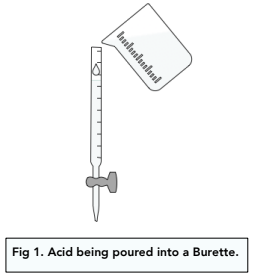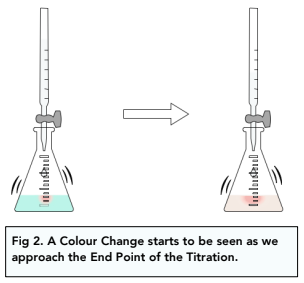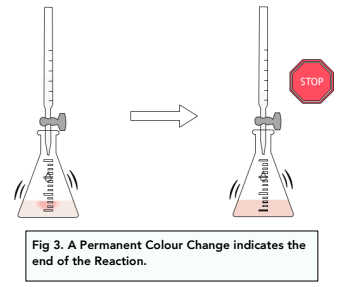Acids and Bases - Titrations (A-Level Chemistry)
Titrations
Titration of Acids and Bases
What is Titration?
A titration is an experiment through which the concentration of an unknown acid or alkali can be calculated.
When an acid and alkali react together, a neutralisation reaction occurs. If we have an unknown concentration of acid, we can do a titration to see how much acid is needed to neutralise a standard solution of alkali (of known concentration), and vice-versa.
Steps of Titration
The steps in the titration are as follows:
1. Fill up a burette with acid. A burette is used to place the acid of unknown concentration. A burette is preferred to a measuring cylinder, as it is more precise.

2. Use a pipette to add alkali to a conical flask. A volumetric pipette is used to deliver a fixed volume of standard solution of alkali into a conical flask. This is also more precise than a measuring cylinder.
3. Add an indicator to the alkali. An indicator is added to the alkali in the conical flask, which causes a colour change to occur.
4. Slowly add the acid into the alkali. The acid from the burette is allowed to run into the alkali, swirling constantly to ensure the reactants mix well.
5. Slow the adding of acid when the indicator changes colour. When the colour from the indicator changes, the flow of the acid is slowed so that it is added drop by drop.

6. Stop adding acid when there is a permanent colour change. When the colour of the indicator produces a permanent colour change. The flow of acid is stopped.

7. Record the titre. The volume of acid delivered, known as the titre, is recorded.
8. Repeat the titration. The titration is repeated until concordant (within 0.1 cm³) titres are obtained.
Calculating Concentration of Acid
The known volume and concentration of the alkali enable the moles to be calculated.
The balanced symbol equation enable the moles ratio of acid:alkali to be determined. Hence the number of moles of acid can be calculated.
The mean titre is the volume of the acid. Using the moles and the volume, the concentration of the unknown acid can be determined.
FAQs
Titration is a process of measuring the concentration of an unknown solution by adding a known amount of another solution of known concentration until the reaction between the two is complete. Titration can be used to determine the concentration of an acid or a base in a solution.
In acid-base titration, an acid or a base of unknown concentration is reacted with a base or an acid of known concentration, respectively. The reaction between the two solutions is typically monitored using a pH indicator, which changes color as the pH of the solution changes.
The endpoint of the titration is reached when the reaction is complete, and the pH indicator changes color. At this point, the amount of the known solution that has been added is used to calculate the concentration of the unknown solution.
The equation for an acid-base titration is typically:
acid + base → salt + water
The purpose of a Titration in A-Level Chemistry is to determine the concentration of an unknown substance. This helps in determining the strength of an acid or a base and understanding how much of it is required to react with another substance.
An Acid in Chemistry is a substance that releases hydrogen ions (H+) in water. These ions are responsible for making the solution acidic.
A Base in Chemistry is a substance that releases hydroxide ions (OH-) in water. These ions are responsible for making the solution basic or alkaline.
The difference between a Strong Acid and a Weak Acid is their concentration of hydrogen ions (H+) in water. Strong Acids have a high concentration of H+ ions and Weak Acids have a low concentration.
The difference between a Strong Base and a Weak Base is their concentration of hydroxide ions (OH-) in water. Strong Bases have a high concentration of OH- ions and Weak Bases have a low concentration.
The steps involved in a Titration Experiment are:
Prepare a solution of the known substance (base)
Add a few drops of an indicator to the unknown substance (acid)
Slowly add the known substance (base) to the unknown substance (acid) until a color change occurs
Measure the volume of the known substance (base) used in the reaction
Calculate the concentration of the unknown substance (acid)
An Indicator is used in a Titration Experiment to determine when the reaction between the known substance (base) and the unknown substance (acid) is complete. The color change of the indicator indicates the end point of the reaction.
It is important to have an accurate measurement in a Titration Experiment because it directly affects the accuracy of the concentration of the unknown substance (acid). Any error in measurement can result in incorrect results.






Still got a question? Leave a comment
Leave a comment